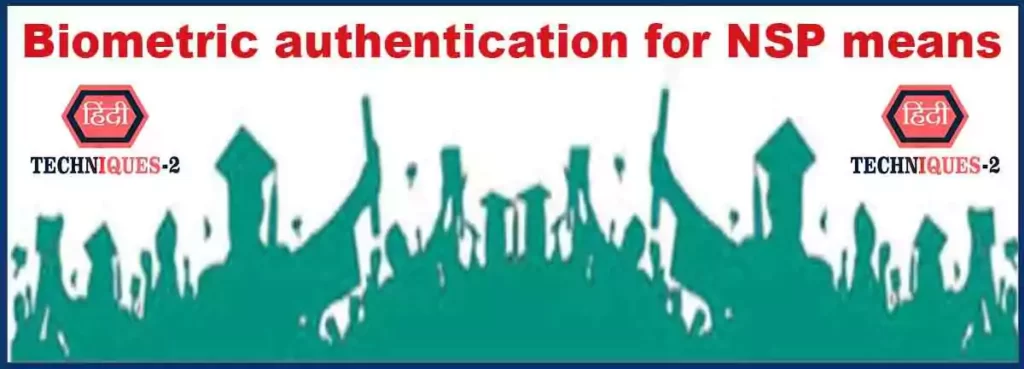Last updated on September 19th, 2023 at 07:10 pm
Biometric authentication for NSP means. Biometric authentication for the National Scholarship Portal (NSP) is a sophisticated and secure process that verifies the identity of applicants through unique physical and behavioral characteristics, such as fingerprints, iris patterns, or facial features. This cutting-edge technology ensures the accuracy and integrity of the scholarship application and distribution process. Let’s explore the Biometric authentication for NSP means in detail.
Biometric authentication for NSP means.
We have already talked about National Scholarship Biometric Authentication. In our blog Hindi Techniques, we have written many articles related to this. In the previous article, we told you how to apply for biometric authentication in National Scholarship. Similarly today in this article we are going to tell you what is the meaning of NSP Biometric Authentication. So let’s start friends.
But before starting the article, let us tell you that we will answer many more questions related to National Scholarship Biometric Authentication in this article. We have given some of these questions below.
Related Searches.
- Biometric authentication for NSP means
- Purpose of Biometric Authentication.
- Enrollment and Verification.
- Unique and Immutable Characteristics.
- Aadhaar Integration & Authentication Process.
- Impact on Timely Disbursement.
- How to Do Biometric Authentication for NSP.
- NSP biometric authentication meaning.
- NSP Biometric Authentication Meaning in Telugu.
- Biometric Authentication for the Scholarship’s Last Date
- Dear applicant you are requested to get your biometric authentication.
- Your application has been sent back to the institute for revalidation by the Ministry of minority.
Purpose of Biometric Authentication.

The purpose of Biometric Authentication within the context of the National Scholarship Portal (NSP) is to ensure the accurate and secure verification of the identity of scholarship applicants and beneficiaries. Biometric Authentication utilizes unique biological characteristics, such as fingerprints or iris scans, to establish a reliable and tamper-proof link between the individual and their scholarship application.
This process enhances the integrity of the scholarship disbursement system by preventing impersonation and fraud. By implementing Biometric Authentication, the NSP aims to achieve the following objectives:
- Accurate Identity Verification: Biometric Authentication verifies the true identity of scholarship applicants, ensuring that the right person is receiving the scholarship funds.
- Prevent Fraud: Biometric features are nearly impossible to replicate, reducing the risk of fraudulent activities and unauthorized access to scholarships.
- Enhanced Security: Traditional methods of verification, such as documents and IDs, can be susceptible to manipulation or forgery. Biometric Authentication offers a higher level of security against such risks.
- Streamlined Process: Once a beneficiary’s biometric data is authenticated, subsequent processes, such as renewal and re-validation, become more efficient and reliable.
- Timely Disbursement: By confirming the identity of recipients, the scholarship disbursement process becomes more accurate and timely, ensuring that deserving students receive their funds without delays.
- Minimize Errors: Biometric Authentication reduces the chances of errors that might arise from manual verification processes, leading to a more accurate and error-free scholarship distribution.
- Data Privacy: Biometric data is unique to each individual and is securely stored. It adds an extra layer of privacy and confidentiality, as it is not shared with third parties.
- Deterrent to Duplicate Applications: Applicants attempting to submit multiple applications under different identities can be identified and prevented through the biometric verification process.
Enrollment and Verification.
Applicants are required to provide their biometric data, such as fingerprints or iris scans, during the enrollment process. This data is linked to their Aadhaar card, a unique identification number issued by the government. During verification, the biometric data is compared against the Aadhaar database to establish the applicant’s identity.
Unique and Immutable Characteristics.
Biometric features are unique to each individual and remain relatively unchanged throughout their life. This makes biometric authentication a reliable method to verify identity, as it is difficult to replicate or manipulate these characteristics.
Aadhaar Integration.
Aadhaar, which is a 12-digit unique identification number, is used as a central component of the biometric authentication process. It acts as a link between the applicant’s biometric data and their personal information stored in the Aadhaar database.
Authentication Process.
When applicants undergo the biometric authentication process, their provided biometric data is compared with the data stored in the Aadhaar database. This comparison is carried out using advanced algorithms to determine if there is a match.
Live Authentication.
In some cases, the authentication process may require live interaction with the applicant. For instance, the system may prompt the applicant to provide a live facial image or iris scan to ensure that the biometric data is being provided in real-time and not from a stored image.
Security Measures.
Biometric authentication is considered highly secure due to the uniqueness of biometric traits and the encryption methods used to transmit and store the data. Additionally, stringent data privacy regulations ensure the protection of applicants’ sensitive information.
Preventing Fraud and Errors.
By incorporating biometric authentication, the NSP aims to eliminate instances of fraud, impersonation, and errors in scholarship distribution. This helps in ensuring that only eligible applicants receive the scholarships.
Impact on Timely Disbursement.
While biometric authentication adds an additional step to the application process, it contributes to the overall accuracy and legitimacy of scholarship disbursement. Once the biometric authentication is successfully completed, the scholarship amount can be disbursed in a timely manner.
How to Do Biometric Authentication for NSP.
Here is a step-by-step guide on how to perform Biometric Authentication for the National Scholarship Portal (NSP):
| Step | Instructions |
|---|---|
| 1 | Log in to the NSP portal using your credentials. |
| 2 | Navigate to the “Biometric Authentication” section, usually found under the “Profile” or “Settings” tab. |
| 3 | Select the type of biometric authentication required, which could be fingerprint or iris scan, depending on the available options. |
| 4 | Follow the on-screen instructions to place your finger on the fingerprint scanner or position your eye for the iris scan. |
| 5 | Ensure that your biometric data is correctly captured and verified. If the system indicates a successful authentication, proceed to the next step. |
| 6 | Save and update your biometric data in your profile. |
| 7 | Confirm the biometric authentication by entering any additional required details, such as an OTP (One-Time Password) sent to your registered mobile number. |
| 8 | Review the biometric authentication status in your NSP profile. It should show as “Successfully Verified” or a similar message. |
| 9 | Once your biometric authentication is completed, your profile will be updated, and you’ll be eligible for various scholarship-related processes. |
Remember that the steps may vary slightly based on the NSP portal’s interface and the specific instructions provided. It’s essential to carefully follow the guidelines presented during the biometric authentication process to ensure accurate and successful verification.
Biometric authentication adds an extra layer of security and accuracy to the NSP platform, ensuring that only genuine applicants can access and benefit from the scholarships. It helps prevent fraud, enhance data privacy, and streamline the scholarship application and disbursement processes.
Biometric Authentication Meaning.
Biometric Authentication refers to the process of verifying an individual’s identity based on unique biological traits or characteristics. These traits can include fingerprints, iris patterns, facial features, voice patterns, and more. Biometric authentication is widely used to enhance security and ensure the accuracy of identity verification in various applications, including access control systems, financial transactions, and online platforms.
As of 19th September 2023, the significance of biometric authentication has taken on a new dimension in the context of NSP scholarships for the year 2023. This year, the process of disbursing NSP scholarships has incorporated a novel approach. While traditionally scholarships are credited to students’ accounts in the month of July, the introduction of new security measures mandates all students to undergo biometric authentication to confirm their identity.
Previously, the last date for completing the biometric authentication process was set for 13th September 2023. However, recognizing the challenges faced by some students in completing this process, the authorities have extended the deadline to 30th September 2023. This extension provides students with additional time to ensure their biometric authentication is successfully completed.
Once a student’s biometric authentication is successfully completed before the revised deadline of 30th September 2023, their scholarship funds will be processed and credited to their accounts by 30th September. This enhanced security measure not only aims to safeguard the scholarship distribution process but also underscores the commitment to ensuring accurate and secure identity verification for all scholarship recipients.
Here’s a table summarizing the key aspects of Biometric Authentication:
| Aspect | Description |
|---|---|
| Definition | Biometric Authentication involves using distinctive physical or behavioral traits to confirm an individual’s identity. It relies on the uniqueness of these traits for accurate identification. |
| Types | Various types of biometric data can be used, such as fingerprints, hand geometry, facial recognition, iris scans, voice recognition, and even DNA. |
| Process | During biometric authentication, an individual’s biometric data is captured using sensors or cameras. The data is then compared to pre-stored data to determine a match. |
| Advantages | Biometric authentication offers heightened security, as these traits are difficult to forge or replicate. It eliminates the need for passwords or PINs, reducing the risk of unauthorized access. |
| Applications | Biometric authentication is used in physical access control, mobile devices, online services, banking, healthcare, and government identification systems. |
| Challenges | Challenges include concerns about privacy, potential data breaches, and the need for specialized hardware or software for accurate verification. |
| Reliability | Biometric authentication is considered reliable due to the uniqueness of biometric traits, but accuracy can vary based on the quality of data and environmental factors. |
Biometric Authentication Meaning in Telugu.
“బెయోమెట్రిక్ ధృవీకరణ” అంటే వ్యక్తిగత భౌతిక లేదా ఆచరణాత్మక గుణాలను ఆధారంగా వ్యక్తిత్వం ధృవీకరించే ప్రక్రియ. NSP సందర్భంగా, ఇది తప్పకుండా అర్హతలు పొందే అభివృద్ధులు ఆధార్ డేటాబేసును సరిచూస్తుంది, అందునికి నమోది చేసిన బెయోమెట్రిక్ డేటాను పరిస్థితులు సరిపించి ఉంచుకున్నారు.
Biometric Authentication Meaning in Hindi.
“बायोमेट्रिक प्रमाणीकरण” एक व्यक्ति की पहचान की प्रक्रिया है जो उनकी विशिष्ट भौतिक या आचारिक गुणों की आधारित होती है। NSP के संदर्भ में, यह सुनिश्चित करता है कि सही पात्र छात्रवृत्तियों को प्राप्त होती है और पंजीकरण के दौरान प्रदान किए गए बायोमेट्रिक डेटा को आधार डेटाबेस के साथ मिलाता है।
Biometric Authentication for the Scholarship’s Last Date.

For scholarship applicants, completing biometric authentication on the National Scholarship Portal (NSP) is crucial. The last date for biometric authentication plays a significant role in determining the timely disbursement of scholarships. It is advised to complete the biometric authentication process well before the specified deadline to ensure that the scholarship amount is disbursed to the eligible candidates on time.
NSP Aadhaar Authentication.
The NSP Aadhaar authentication is an essential step in the biometric authentication process. Applicants link their biometric data, such as fingerprints or iris scans, with their Aadhaar card. This linkage ensures the accuracy and authenticity of the applicant’s identity, preventing any fraudulent activities.
National Scholarship Portal Biometric Authentication.
The National Scholarship Portal (NSP) Biometric Authentication is a technologically advanced process that employs unique biological and behavioral traits, such as fingerprints and iris scans, to establish the identity of scholarship applicants. Linked with India’s Aadhaar system, this method enhances security, reduces fraud, and ensures accurate verification, leading to efficient and transparent scholarship distribution.
Through biometric authentication, eligible students receive timely disbursement of funds, contributing to a fair and inclusive educational support system.
Dear applicant you are requested to get your biometric authentication.
The message is informing the recipient, who is an applicant, that they are required to undergo biometric authentication. This process involves verifying their identity using distinctive physical or behavioral characteristics like fingerprints.
The purpose of this authentication is to ensure the accuracy and security of their information, contributing to a more robust and reliable verification process. The applicant is instructed to follow the provided guidelines to successfully complete the biometric authentication step.
Your application has been sent back to the institute for revalidation by the Ministry of Minority.
This message means that your scholarship application has been returned to your educational institute for further verification and validation by the Ministry of Minority Affairs. It indicates that there might be some additional checks or updates required before the application process can proceed.
As of 19th September 2023, you should contact your institute’s designated authority or follow the instructions provided to address any necessary actions or Biometric Authentication for the revalidation of your application.
Conclusion.
Biometric authentication is a technologically advanced and secure method used by the NSP to verify the identity of scholarship applicants. This process enhances the overall integrity of the scholarship distribution system and helps ensure that scholarships reach deserving students.
Faq’s
What are the benefits of Biometric Authentication?
Biometric Authentication ensures secure and accurate identification, preventing fraud and ensuring fair scholarship distribution.
How does Biometric Authentication work?
Biometric Authentication involves using unique biological features like fingerprints and iris scans to verify the applicant's identity and eligibility for NSP scholarships.
Thanks
You may also like the given articles…
NSP biometric authentication utility
How to find acknowledgment number of the pan card
How to apply at UNISA for 2024 online




